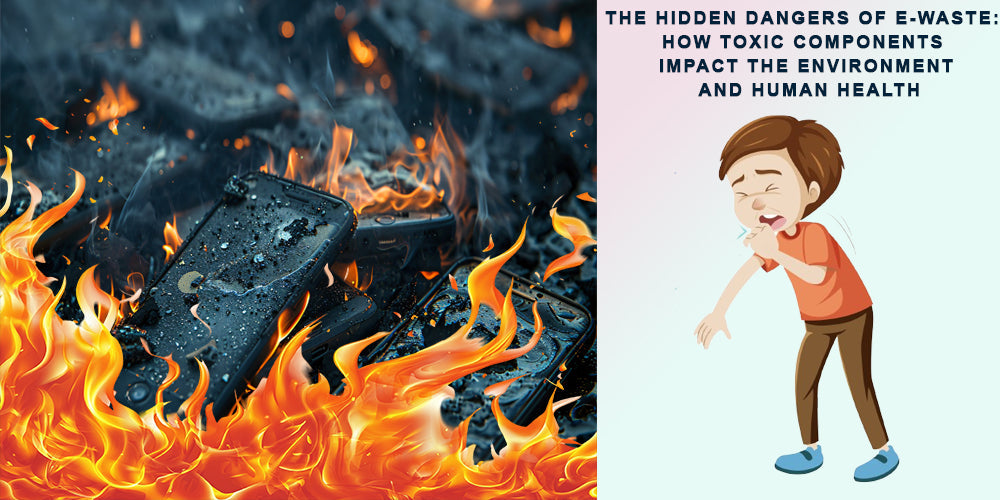Introduction: Understanding the Growing Threat of E-Waste
The world has never produced so much e-waste. Discarded phones, computers, and Laptops alike lay stacked in the landfill. The chemicals present in E-waste are polluting poison for nature. Landfilling E-waste worsens human health directly. The dangers of E-waste are not known to many. For dealing with this burgeoning issue, emphasis must be put on sustainable waste solutions. A big shift in sustainable waste disposal is needed. Sustainable waste practice reduces damage, a practice which includes reuse and recycling. E-waste would continue to be a menace to our planet if not dealt with properly. Smart and sustainable waste programs ought to be implemented now.
Toxic Chemicals in E-Waste: A Silent Environmental Disaster
E-waste contains harmful metals like lead, mercury, and cadmium. This is harmful to soil and water. When E-waste is dumped into the nature improperly, the chemicals begin to leach into the environment. They contaminate rivers and kill aquatic life downstream. This is why the need for sustainable waste practices arises. People should be educated on the dangers of disposal of E-waste. Unless they are being recycled properly, disposing of electronics is not a sustainable disposal method. The right way is to recycle them so the E-waste becomes less harmful to nature. Recycling and repairing are the antidote in a sustainable waste system. The toxic E-waste must be stopped before it is too late.
Human Health at Risk: E-Waste and Its Toxic Impact
E-waste causes threats not just to the earth but also to human life. Workers of the unorganized recycling industry work with E-waste without an approved safety procedure. They breathe toxic fumes and touch hazardous metals. It leads to health conditions such as cancer, nerve destruction, and respiratory diseases. Sustainable waste handling keeps people away from these dangers. We need better laws on sustainable waste disposal for the protection of workers. Children living around these E-waste dumps are also in danger. They play in these contaminated areas and fall sick. Safe and sustainable waste practices are needed across the globe. Let the human cost of E-waste be something we pay less now.
-
Toxic Exposure – Informal workers handle E-waste without protection, leading to exposure to harmful metals like lead and mercury.
-
Serious Illnesses – Contact with E-waste can cause cancer, lung damage, nervous system disorders, and skin diseases.
-
Child Vulnerability – Children near E-waste sites face high health risks from contaminated soil, water, and air.
-
Unsafe Recycling – Burning or dismantling E-waste without safety leads to inhalation of toxic fumes.
- Need for Sustainable Waste – Proper sustainable waste methods are crucial to protect human health from the dangers of E-waste.
The Global Impact of E-Waste: A Problem Beyond Borders
E-waste is a global problem. Mostly developed countries send E-waste to the poor nations. These nations lack proper sustainable waste systems. As a result, unsafe handling of E-waste and unregulated dumping go on. This creates pollution worldwide. We cannot deal with E-waste only in a local manner. We need international cooperation in sustainable waste. Rich countries should set up recycling plants with their own funds in poor regions. Sustainable waste means international work and joint initiatives. No one should become a victim of E-waste from across another country. The earth is interrelated and so is pollution. Only with joint sustainable waste efforts can the E-waste problem be taken care of.
The Role of Recycling in Combating E-Waste Pollution
E-waste recycling is a perfect method for combating E-waste issues. Having said that, mostly people tend to just throw away their gadgets. Recycling helps to prevent toxic substances from settling into landfills. An effective sustainable waste policy should include good recycling programs. People should be aware of where and how they can recycle E-waste. Also, businesses should support sustainable waste by accepting old products back. Repairing and reusing electronics are part of that sustainable waste circle. We prolong using items as one way to decrease E-waste. Recycling conserves energy and lessens pollution. Proper recycling is a step towards a safer and cleaner future. Fonezone appreciates the grave implications E-waste pose on the environment. By recycling old phones and electronics, we reduce pollution, conserve energy, and keep toxic substances from damaging our planet. Proper E-waste recycling is the sure way to secure the future to a cleaner one. So join Fonezone today in the safe enterprise by making sensible waste decisions.
How Consumers Can Help: Building a Sustainable Future
Everyone has a share in managing E-waste. Instead of dumping gadgets in landfills, businesses should donate or repair them. This reduces E-wastes and keeps working gadgets in circulation. Choosing durable and long-lasting gadgets is also a way of supporting sustainable waste. People need also to learn about the effects of E-wastes on health and the environment. Awareness is the beginning of any sustainable waste action. Support brands that follow sustainable waste guidelines and eco-friendly designs. Recycling and reuse reduce demand for new raw materials. Everyone can help by reducing E-waste at home. Together, small changes make a big impact on sustainable waste management.
-
Recycle old electronics at certified collection points to reduce E-waste.
-
Repair and reuse devices instead of replacing them quickly.
-
Donate working gadgets to those in need rather than throwing them away.
-
Buy durable and energy-efficient products that last longer.
-
Support brands that follow sustainable waste and eco-friendly practices.
-
Learn about E-waste risks to make informed choices.
-
Reduce gadget upgrades to slow down E-waste growth.
-
Participate in take-back programs offered by manufacturers.
-
Avoid throwing electronics in trash bins to prevent environmental damage.
- Spread awareness about proper E-waste disposal in your community.
Conclusion: Act Now to Reduce E-Waste Hazards
E-waste poses the increasing threat to mankind and the environment. Toxic parts of E-waste do some long management. If not handled properly, they would threaten the presence of clean and pure air and water, including health. So, the effective protection of Mother Earth demands adoption of sustainable waste methods. Recycling, reusing, and disposing of waste form E-waste reduction. Therefore, Governments, companies, and individuals have to put all their efforts together. The future is in our hands now. Sustainable waste practices are the consideration to the hidden crisis. Let us learn to make smart, safe, and clean choices in managing E-waste. The time for sustainable waste management is now!
Frequently Asked Questions
Q.1. What is E-waste?
E-waste stands for electronic waste. It includes old or broken electronic items like phones, laptops, and computers.
Q.2. Why is E-waste dangerous?
E-waste contains toxic metals like lead and mercury that harm the environment and human health.
Q.3. What is sustainable waste management?
Sustainable waste management means using safe, eco-friendly ways to reduce, reuse, and recycle waste.
Q.4. How can I reduce E-waste at home?
Repair, donate, or recycle electronics instead of throwing them away. Buy long-lasting devices.
Q.5. Can E-waste be recycled safely?
Yes, E-waste can be recycled safely at certified centers with proper methods and protections.






















